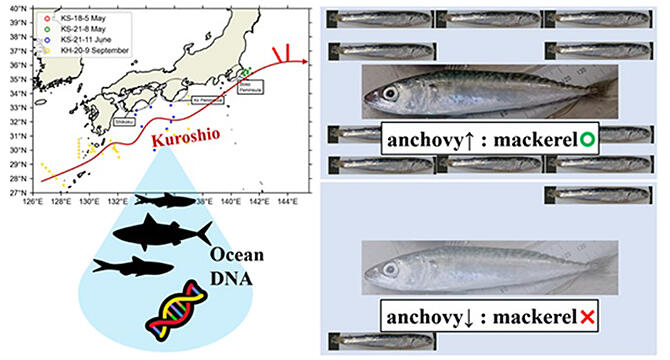The research group led by Professor Shin-ichi Ito and Professor Susumu Hyodo of the Atmosphere and Ocean Research Institute (AORI) at the University of Tokyo announced that they have clarified the distribution characteristics of small pelagic fish species in the waters surrounding the Kuroshio Current using a quantitative polymerase chain reaction (qPCR) method, an environmental DNA analysis method originally developed for the study of small pelagic fish of the blue fish group. The research group found that the distribution of Japanese sardine and Japanese anchovy was strongly dependent on water temperature, whereas that of mackerel species such as chub mackerel and blue mackerel was strongly dependent on their prey, Japanese anchovy. The results are expected to lead to more accurate predictions of the distribution of piscivorous fish species under the influence of global warming. The results were published in the 01 June 2023 issue of the international journal Frontiers in Marine Science.

Provided by the University of Tokyo
Small pelagic fish such as Japanese sardine, Japanese anchovy, blue mackerel, and chub mackerel, collectively known as blue fish, are caught in large numbers and are widely used not only for human consumption but also as raw materials for animal feed, fertilizer and other products. These fish inhabit the regions close to surface of the ocean, and the amount caught fluctuates greatly under the influence of climate change. It has been pointed out that fish are ectotherms (their body temperature changes according to the ambient water temperature), and that their distribution is shifting to higher latitudes as global warming progresses. However, the speed of this shift differs among species, and the actual distribution and its underlying mechanism needs to be clarified.
In this study, the research group analyzed environmental DNA in seawater samples collected over a wide area in the Kuroshio Current, where small pelagic fish are abundant. They then compared the results in relation to the simultaneously recorded water temperature, salinity, seawater oxygen concentration, and chlorophyll content (an indicator of phytoplankton). Seawater samples from the Kuroshio Current were collected by the Tohoku Marine Ecosystem Research Vessel 'Shinsei Maru' during three research cruises (May 2018, May and June 2021) and by the academic research vessel 'Hakuho Maru' (September to October 2020). The seawater samples collected from the three voyages of the 'Shinsei Maru' during the same season were analyzed for the detectable presence or absence of each fish species, and the relationship between the DNA concentrations and environmental factors.
Similar to previously reported findings, the results showed that the distribution of Japanese sardine and Japanese anchovy was strongly dependent on the water temperature, with a tendency of Japanese sardine being detected more frequently at low temperatures and Japanese anchovy being detected more frequently at high temperatures. In contrast, the distributions of mackerel species were more dependent on that of Japanese anchovy than on the water temperature.
The detection frequency of chub mackerel increased with increasing environmental DNA concentration of Japanese anchovy. Blue mackerel were detected more frequently in areas with higher concentrations of Japanese anchovy environmental DNA.
This detection method is expected to become more widely used than traditional fishing gear surveys as it is simpler and can be applied over a wider area.
Journal Information
Publication: Frontiers in Marine Science
Title: Environmental DNA in the Kuroshio reveals environment-dependent distribution of economically important small pelagic fish
DOI: 10.3389/fmars.2023.1121088
This article has been translated by JST with permission from The Science News Ltd. (https://sci-news.co.jp/). Unauthorized reproduction of the article and photographs is prohibited.




